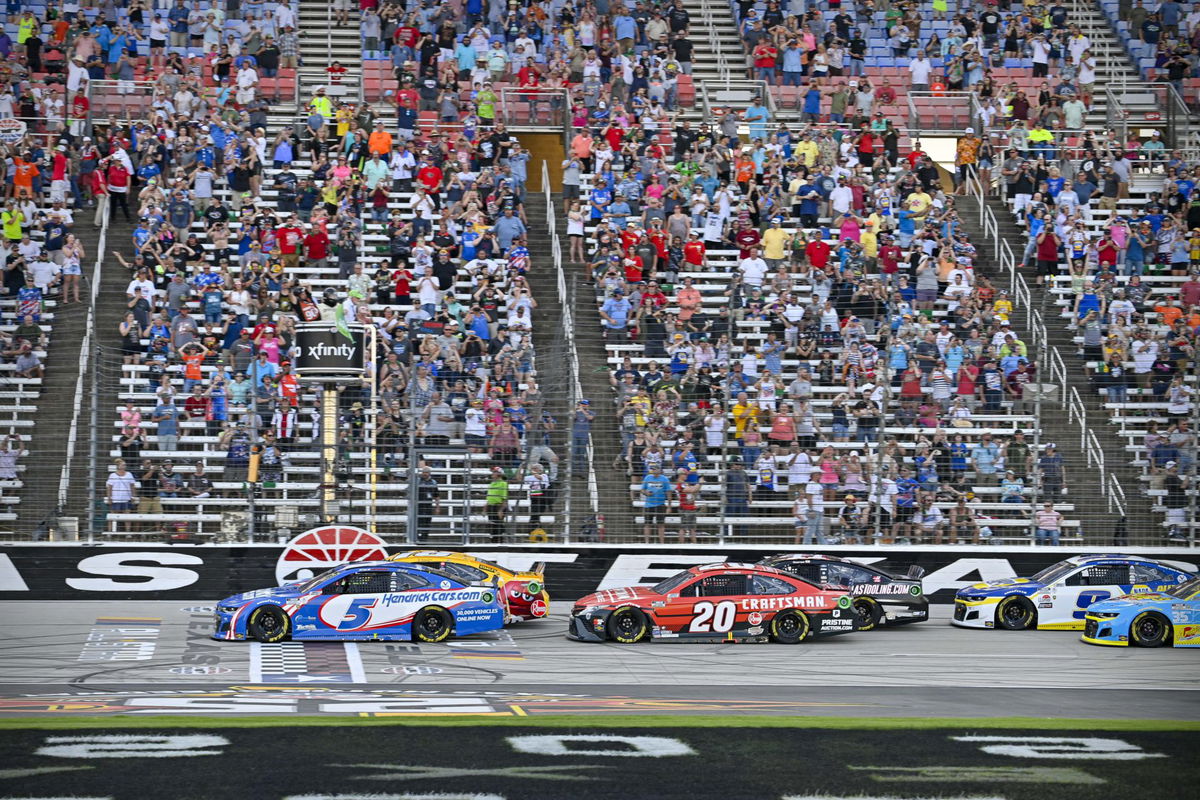
USA Today via Reuters
Jun 13, 2021; Fort Worth, TX, USA; NASCAR Cup Series driver Kyle Larson (5) and driver Kyle Busch (18) and driver Christopher Bell (20) and driver Cole Custer (41) and driver Chase Elliott (9) lead the field at the start of the NASCAR All-Star Race at Texas Motor Speedway. Mandatory Credit: Jerome Miron-USA TODAY Sports

USA Today via Reuters
Jun 13, 2021; Fort Worth, TX, USA; NASCAR Cup Series driver Kyle Larson (5) and driver Kyle Busch (18) and driver Christopher Bell (20) and driver Cole Custer (41) and driver Chase Elliott (9) lead the field at the start of the NASCAR All-Star Race at Texas Motor Speedway. Mandatory Credit: Jerome Miron-USA TODAY Sports
There are some tracks that drivers really enjoy racing on, and some tracks where they want to see drastic steps taken. The Texas Motor Speedway certainly falls into the latter category. The track was repaved back in 2017, and since then, it has mostly been a horror show. NASCAR Sunday was no different, as the race saw cautions in double figures, including one that decided the fate of the race with two laps to go when Denny Hamlin spun out while fighting Chase Elliott for the win. The Joe Gibbs Racing star was not the only one who faced issues throughout the race.
Watch What’s Trending Now!
Bumps, residual traction compounds, or banking—what ruined several drivers’ runs?
Countless drivers spun out without any sort of contact, and it was all down to the track. According to the FOX commentary team, there were bumps somewhere around turns 3 and 4 that compromised a lot of runs. Denny Hamlin himself spun out as he was entering 4, handing Chase Elliott the race win. The track was last repaved in 2017, and after complaints of being too slippery by drivers, the traction compound PJ1 was added in 2019. That year, the spring race at the track was quite enjoyable, but the PJ1 ended up being detrimental in the long run.
ADVERTISEMENT
The issue was staining. Although it was not being applied to the track anymore, there was enough PJ1 in the spaces in between the asphalt to have an impact. On Sunday in the NASCAR Cup Series, we saw drivers do their best to avoid the top lane because that is where the compound was laid 5 years ago. The top lane saw a litany of crashes as several cars got loose in that area of the race track. That’s what makes every single turn tough on this track.
HAMLIN SPINS!! pic.twitter.com/gK7VbOv9hM
— NASCAR (@NASCAR) April 14, 2024
In the 2017 repave, turns 1 and 2 were reconfigured, and their banking was reduced so that drivers could pass more easily. However, that resulted in a drastic drop in grip, which in turn resulted in NASCAR being forced to use the PJ1 traction compound only at those two turns. Then come turns 3 and 4. There are several bumps on that part of the track, and if someone’s car is not facing straight, they will spin on most occasions. That was evident with the number of cautions on Sunday.
ADVERTISEMENT
After a series of issues in Texas for NASCAR, is there any hope?
The record for the most cautions in a NASCAR Cup Series race is 16, and Sunday’s race saw 15. There has been a pattern at the track that there will be a high number of cautions. In the last three races at the venue, there have been a total of 43 cautions, which is quite incredible if you think about it. That’s almost like 15 cautions in every single one of those races. It has been 7 years since the repave, and the track is quite wide, but the lanes that have enough traction do not cover the entirety of the track. This makes the racing action quite narrow.
ADVERTISEMENT
15 cautions today…record is 16.
Keep in mind that the 16 came in a 500-mile race; this one is 400 miles.#NASCAr #EchoParkAutomotive400
— Stephen Stumpf (@stephen_stumpf) April 14, 2024
However, there might be hope for the Texas Motor Speedway just yet. A lot of people may call for another repave, but according to a report in Frontstretch, Sunday’s race saw some positives. Firstly, tire strategy played a part in the race, and under the conditions, the groove was as high as it has been ever since the track’s repave in 2017. NASCAR has stopped putting down any more compounds on the track, and it is having a positive result. So maybe the track should be given a few more chances.
However, issues with the venue have been there since before the repave in 2017. Back then, the problem was that passing was almost impossible. That’s what caused them to repave and reconfigure turns 1 and 2 so that passing became simpler. And that’s when all the issues began. So it’s like one problem gave rise to another one. For such an iconic track, that truly is a shame.
ADVERTISEMENT
ADVERTISEMENT
ADVERTISEMENT
ADVERTISEMENT

